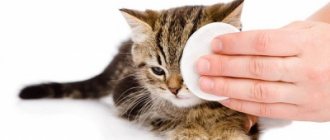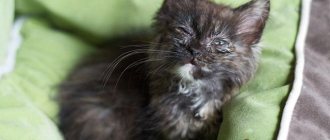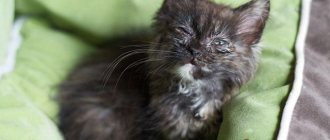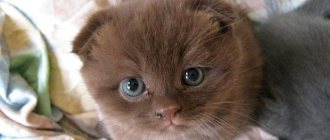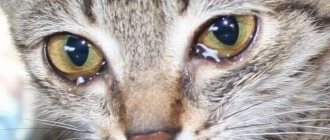It is known that sour eyes in kittens is a normal phenomenon that goes away as the pet grows older. This is due to the fact that babies do not yet know how to wash themselves thoroughly. The owner must come to the rescue by providing good care for the cat. However, sometimes the reason lies in pathological processes occurring in the body. In this situation, you cannot do without consulting a veterinarian. The veterinarian will prescribe the necessary treatment and procedures that will help the kitten overcome the disease.
Causes of purulent discharge
Pus is not only unpleasant, it can even interfere with breathing and swallowing.
The cause of such discharge is nasopharyngeal polyps. This infection often appears in cats after treatment for inflammation of the middle ear and eustachian tube. Discharge may appear due to neoplasms. Along with them, swelling appears, the muzzle begins to deform. Most often this happens to old animals suffering from adenocarcinoma, lymphosarcoma, fibrosarcoma, osteosarcoma.
Pus in a cat can be a symptom of a serious illness. The cause of purulent discharge may be:
- Mechanical damage to the nose with inflammation;
- Congenital pathologies such as cleft palate;
- Viral diseases (calcivirus infection or herpes);
- Toxoplasmosis;
- Entry of foreign bodies (for example, seeds);
- Panleukopenia or feline distemper;
- Chlamydial pneumonia.
If the cat has caught an infection, then discharge may also come from the eyes, the cat may sneeze and hide in a corner. You can take your temperature: if you are sick, it will be elevated.
Pus is much more serious than clear discharge and is never caused by a common cold. The disease is much more serious than a simple runny nose, and therefore you should consult a doctor. He will prescribe the right medications and dosage for your cat.
In kittens, discharge may occur for other reasons. Pus can appear from hypothermia, poor nutrition and living conditions, lack of care or early separation from the mother cat.
© shutterstock
Associated symptoms
Deterioration of the condition is accompanied by the following symptoms:
- hot nose;
- temperature increase;
- apathy;
- weakness;
- loss of appetite;
- sometimes blood comes from the nose;
- a sharp decrease in body weight;
- ulcerations, skin rash;
- purulent discharge from the eyes, nasal passages;
- breathing is accompanied by whistling, wheezing;
- cough;
- gagging;
- diarrhea.
These signs indicate the development of a serious illness. Immediate veterinary assistance is needed.
Why do my eyes fester?
Kittens that were recently born are weak and susceptible to various diseases. Because of this, sometimes the kitten’s eyes become very purulent; the discharge can be so profuse that the baby’s eyes don’t even open.
There are many reasons for the occurrence of this condition, as well as eye diseases, and it is not always possible to find out why the kitten is suffering:
- virus;
- draft;
- speck in the eye.
All these are possible irritants that can cause the eyes of a small kitten to fester. One of the common causes of exudate is conjunctivitis. Among other things, a kitten can injure its eye while playing or conflicting with another pet. At first it may be a simple wound, which then becomes infected.
Little animals are very curious creatures, they strive to stick their nose somewhere. Sometimes the nose ends up in the wrong place and household chemicals, detergent, etc. get into the animal’s eyes. If the kitten's eyes are festering and sneezing, check the place where he sleeps; the cause of complications may be a cold due to a draft.
The kitten's eyes become purulent and swollen due to a disease called blepharitis. The disease occurs as a result of chemical, thermal, traumatic effects on the eyelids. The danger is not the damage itself, but the viruses, microbes and pathogenic fungi that infect the affected area. Inflammation of the cornea (keratitis) is another disease that causes a kitten’s eyes to fester and become swollen.
If the discharge is profuse and constant, the kitten should be shown to a veterinarian. The specialist will determine the root cause that caused the suppuration of the organ of vision and prescribe appropriate therapy.
Allergic eye diseases in children
11.01.2021
Due to their anatomical location, eyes are considered the most vulnerable organs to the environment - sunlight, wind and dust. And the organs of vision are open to exposure to a wide variety of allergens that may be present in air masses.
It is worth noting that allergic reactions are three times more common in males than in females. are especially predisposed to developing eye allergies than children living in villages and towns.
Popular allergens and heredity
A factor such as heredity also plays a big role. If the father or mother has an allergy , then the probability of the child developing the same disease is more than 25%, and if both parents, then already 50%.
The list of the most popular allergens includes:
- mold;
- dust;
- pollen;
- dander and animal hair;
- household chemicals;
- down and feathers;
- cosmetics and medicines;
- perfumery.
Eye allergies can also be caused by medications. eye , contact lenses, solutions for their care, and moisturizers to relieve eye may not be suitable .
Causes and types of eye allergies
Allergic eye can also occur from products that contain certain conservative substances and chemical additives.
There are a huge number of varieties of allergic eye , depending on the nature of the manifestation and the location of the lesion.
Allergy symptoms are:
- redness of the eyes ;
- lacrimation;
- swelling of the upper and lower eyelids;
- the appearance of allergic conjunctivitis ;
- seasonal occurrence of conjunctivitis.
There are several types of conjunctivitis:
- hay fever is a predominantly seasonal disease that is caused by pollen during the period of active flowering. The disease is accompanied by frequent sneezing, attacks of suffocation and persistent runny nose ;
- Allergic conjunctivitis can manifest itself both in an acute form and in a protracted form that develops into a chronic one. It can appear due to the consumption of a number of products and from chemical elements contained in household products. Allergic reactions most often occur from 1 year to 7 years. A characteristic sign of this disease are periods of exacerbation in the spring, during the flowering process.
Vernal keratoconjunctivitis lasts for several years and may continue until puberty or stop earlier. Exacerbations alternate with states of remission.
Recommendations for parents for seasonal allergies in children
If your child begins to actively show symptoms of eye allergies, you should:
- try to reduce external exposure. That is, if you are allergic to drops or other medicine, you need to stop using them;
- provide air conditioning;
- It is better to keep the windows in the house or car closed to prevent air containing allergens , if there is a reaction to pollen or flowering;
- When returning from the street, always make sure that the child washes himself, rinses his hands and puts on other clothes in order to cut off contact with allergens .
If the allergy is year-round and does not depend on natural factors, but, for example, is provoked by household chemicals or the presence of animals in the house, you should:
- exclude all contact with animals to which you are allergic ;
- replace household chemicals with hypoallergenic ones to eliminate symptoms;
- Ventilate the child’s room more often so that the concentrated smell of powders and conditioners disappears more quickly;
- It is important for parents to warn their child not to touch or scratch his eyes .
Itching can be relieved with a cold compress.
treat eye diseases on your own . a doctor for help and strictly follow the doctor's .
Published in Allergology Premium Clinic
Symptoms
The symptoms of purulent discharge, as well as the kitten’s health condition, depend on the cause that caused the appearance of the ichor. Let's look at the main reasons why kittens develop problems and symptoms associated with each specific type of damage:
- Bruised eyelids. If the baby bruises the eyelid, then upon examination you can see a bruise, and adjacent tissues may be crushed. In severe cases, necrosis occurs.
- Wounds of the eyelids, in which the integrity of the kitten’s skin may be compromised, bleeding and pain may occur.
- Blepharitis. The first symptom of blepharitis is redness of the eyelids. If a kitten's eyes are red and festering, this is also one of the signs of illness. In the process of scratching, the pet introduces purulent microflora into the eye: streptococci and staphylococci. Swelling during illness is another symptom.
- Purulent conjunctivitis. Most often, the disease affects both eyes. The kitten looks sick, depressed, and may have a fever. At first, the purulent discharge is liquid, but as the disease progresses, it gradually thickens. The conjunctiva swells and may even protrude beyond the eyes.
- Follicular conjunctivitis. The disease is characterized by damage to the lymph nodes located inside the third eyelid. There is discharge from the conjunctival sac. There is photophobia and pain. The eyelids look swollen. Often the kitten’s eyes do not open and fester, because the ichor sticks together the eyelashes and forms crusts that prevent the opening of the eyelids. The pus irritates the skin around the eyes, which leads to inflammation, dermatitis and eczema develop, and hair loss around the affected area.
Causes
The clearer the doctor understands the cause of the disease, the more effective the prescribed treatment will be. Do not perceive sour eyes as a harmless inconvenience. Behind inflammation of the mucous membranes there is always a threat of loss of vision or even the organ itself. As practice shows, not many owners can accurately describe the symptoms they observe in their pets. Acidity of the eyes is often referred to as:
- Small dry accumulations in the corners of the eyes after sleep are normal and indicate that the mucous membrane is clearing naturally. These secretions just need to be removed, and most often, the cat eliminates them herself while washing.
- Viscous discharge in the corners of the eyes indicates the natural cleansing of the mucous membrane and the presence of weakened unfriendly microorganisms. There is no need to panic; most likely, within a few days, the discharge from the eyes will become normal again.
- After sleep or rest, the lower eyelid is covered with viscous transparent or cloudy discharge - this may indicate a developing inflammatory process or a severe allergic reaction. In both cases, antimicrobial therapy is necessary.
- After sleep, the cat cannot open her eyelids because they are stuck together with secretions or pus - this is most likely conjunctivitis.
Important! Unlike dogs, cats wash their faces, which can hide the first symptoms of eye inflammation.
We will look into the types and causes of conjunctivitis below. Points 2 and 3 describe disorders that have not yet caused harm, but are most likely to develop into a full-fledged illness. There are many reasons for the occurrence of such conditions. You need to analyze the last few days of your pet’s life and identify possible causes of poor health:
- Trauma or foreign body - a cat can injure the mucous membrane of the eye with any small foreign body. Examine the eyes for localized redness and scratches. Pay attention to whether the cat begins to wash itself more often. Very often, cats injure their eyes with dust and small grains of sand if they have the habit of actively digging for litter in the tray.
- Diseases of the gums and teeth - inflammation of the mucous membranes of the mouth always affects the nose and eyes. The tissues become swollen and red. Until the mucous membranes are attacked by microbes, there will be an increased secretion of tears and an increase in their thickness. Your cat's mouth will most likely have an unpleasant odor.
- Food and non-food allergies are a disease that affects all mucous membranes of the body. The eyes become swollen and watery, discharge appears from the nose, and the increased volume of saliva is usually unnoticeable.
- Helminths - in the absence of prevention, the number of parasites increases sharply, which leads to metabolic disorders and more active work of the mucous membranes.
- Infectious, bacterial damage or weakened immunity - the mucous membranes react to the disease almost immediately, the problem is that in cats this change is almost imperceptible. In animals with immunodeficiency, sour eyes and conjunctivitis are considered chronic and almost “normal” phenomena. Infection with streptococci and staphylococci and similar bacteria invisible to the eye leads to secretive processes in the animal’s body. Sooner or later, the neighborhood results in illness, but it all starts with sour eyes, inexplicable itching and a weakened state.
Eye Treatment Basics
At the initial stage of any disease that causes the appearance of exudate, the kitten experiences virtually no discomfort. As a rule, there is no harm to health. The problems start later. Pathogenic microorganisms develop, the amount of pus increases. The discharge begins to irritate the mucous membranes and skin around the eyes. If your pet is left untreated, the possibility of vision loss increases many times over.
Therefore, when a small kitten’s eyes fester, what to do, how and how to treat it are the first questions that the owner of the animal must decide. Let's start with first aid - rinsing. To wash your baby's eyes, make a chamomile decoction, wash off the accumulated ichor and rinse the inflamed eyeball. If you have other pets at home, repeat this procedure with them for preventive purposes.
If rinsing does not help, then it is better not to continue self-treatment. Take your baby to the veterinarian, only he can tell you exactly what to do next. Agree, why think about why a kitten’s eyes are festering, how to treat a sick animal, when there are people qualified to solve these issues. Yes, veterinary services cost money, but here it’s up to you to decide what’s more important – the baby’s health or an unplanned waste of money from the family budget.
Features of the course of ARVI without fever
A respiratory viral infection is localized in the nasopharynx and after a couple of days it manifests itself as a certain discomfort. Following tickling and sneezing, copious watery discharge from the nose appears, which after a couple of days becomes mucous, sometimes mixed with blood and pus.
Medical statistics indicate that the main symptom of ARVI, with or without fever, is a runny nose. Four out of ten patients experience a sore or sore throat, and six out of ten subsequently develop a cough, which has certain characteristics associated with a cold.
Dry and superficial, it is rather a reaction to tickling. But with weak immunity, there is a possibility of it spreading to the upper respiratory tract. Having descended into the trachea and further into the bronchi, the infection can finally cause fever. Although recently there have been frequent cases of bronchitis and pneumonia occurring without a significant increase in temperature. Needless to say, when symptoms of ARVI complications appear in children, they should definitely be shown to a good pediatrician?
If the sick person also suffers from muscle pain and aches throughout the body, then his temperature will probably rise greatly, since in this case, influenza will most likely be diagnosed - the most serious of acute respiratory viral infections.
Therapy
Treatment of purulent discharge is primarily aimed at eliminating the cause of the pathological process. Further treatment measures depend on how correctly it is established. Treatment for purulent eyes in a kitten also depends on the causes of the pathology:
- If the cause is a bruise, the injured area is cleaned with a gauze swab soaked in a solution of hydrogen peroxide. The same applies to wounds of the eyelids.
- If the problem is blepharitis, they look for and remove the cause. It is worth knowing that blepharitis in a kitten can occur due to a lack of vitamins, so if the doctor has diagnosed it, it is necessary to provide the pet with a balanced diet with vitamin supplements.
- When a kitten has snot and purulent eyes due to a cold, the doctor prescribes eye drops and antibiotics. It is important to provide your pet with comfortable living conditions. The baby's crib should be dry and warm, and there should be no drafts in its location. Adding vitamins to your pet's diet will be an additional benefit for the baby's health.
- If the kitten's eyes cannot open due to pus, the exudate crusts are softened before removal. Vaseline oil is used for this purpose. The softened crusts are removed, and the area around the eyes is treated with hydrogen peroxide. The eyes themselves are washed with nitrofural, also known as furatsilin. After treatment, eye drops are instilled or ointment is applied.
Some kitten diseases cause not only discharge from the eyes, but also pain. In such cases, the veterinarian prescribes novocaine with an antibiotic, which is injected into the conjunctival sac.
If the disease is advanced, the bacteria have time to take root firmly in the deep layers of the eye. In this case, the doctor prescribes general antibiotic therapy.
For purulent or phlegmonous conjunctivitis, general and local therapy is used. The course of treatment includes periodic washing of the eyes with boric acid - 3%, and their subsequent treatment with syntomycin ointment or any other eye emulsion with antibiotics. In this case, novocaine blockade with an antibiotic is also used. In addition to the pronounced “freezing” effect, the procedure is useful in general therapeutic terms. Antibiotics can also be administered intramuscularly. In addition, your veterinarian may recommend oral sulfonamides.
Causes and symptoms of sneezing
If a cat has a runny nose and watery eyes, she sneezes often and even more forcefully and rubs her nose with her paw, then these are clear signs of illness.
Under no circumstances should you ignore a cat's sneezing, since inaction can result in disastrous consequences for the baby.
First you need to find out the cause of the disease. It could be:
- Conjunctivitis . This is an inflammation of the mucous membrane of the eye, which causes discomfort and pain in cats. It must be remembered that this disease is transmitted by airborne droplets, and if a pet is sick, then the owner is also at risk. Therefore, as soon as a diagnosis has been made, treatment must be started immediately.
- Allergy . Allergic reactions can be caused by various household items: chemicals and household preparations, cigarette smoke, decorative cosmetics, flowering plants. To accurately identify the cause, you need to undergo a special test at the clinic. After eliminating the allergen from the house, there will be no more tears, and your pet will not sneeze again.
- Anatomical structure . In cat breeds such as Sphynx, Persian and British, the location of the eyeballs and the structure of the nasopharynx differs from animals of other breeds. Because of this, lacrimation and difficulty breathing may appear, that is, the pet will begin to cough.
In special cases, eyelid inversion and abnormal eyelash growth occur. If there are no other diseases, then there is no need to worry, these are just characteristics of the body.
- Viral and colds . As a result of these infections, the mucous membrane of the nose and throat becomes inflamed. Consequently, sneezing is accompanied by discharge from the cat's nose, watery eyes appear and the temperature may rise. If the cat has a strong immune system, then the cold should go away in 5-7 days. But if the pet is weakened, it is recommended to use antibiotics or vitamins.
- Eye diseases . The most common ailments are glaucoma, cataracts and keratitis. These are quite serious diseases, as a result of which the cat can lose vision. Therefore, at the slightest symptoms of illness in your beloved pet, especially when he sneezes, you need to seek help from a veterinarian.
If your cat is constantly sneezing and you notice symptoms such as runny nose, purulent discharge, fever, then these are clear signs of the above infections.
© shutterstock
Do not hesitate to visit the medical center, because delay can negatively affect the health of your pet. Don’t forget: no one better than a specialist can make the correct diagnosis of why a cat is sneezing and watery eyes.
How to treat
Here we will look at the means that are commonly used to wash, wipe, and apply drops to a kitten’s eyes if there is purulent discharge in them. Here is a list of the most commonly used medications:
- drops "Bars";
- tetracycline ointment;
- “Diamond Eyes” drops;
- multifunctional drops "Iris";
- “Anandin – drops with an antiviral effect;
- eye drops "Lakrikan" - for non-viral inflammations;
- "Tsiprovet" in tablets or drops for the treatment of inflammation caused by bacteria.
Most often, the instructions for use indicate the optimal dosage of the medicine, but on average, if a one-month-old kitten has festering eyes, one drop of the drug three times a day is enough for the baby; older pets are instilled with 2 or 3 drops of the prescribed drug.
The medicine is instilled as follows: the lower eyelid is slightly retracted and the drug is applied to the mucous membrane. Make sure that the product does not leak out; for more reliable instillation, the animal’s head can be raised so that the eyes look up.
As improvised means, you will need cotton swabs and a special lotion. But if there is no lotion, you can use chilled boiled water.
How to put drops in a kitten's eyes
A small pet must be handled carefully, and before washing the kitten’s festering eyes, you need to figure out how to hold the animal so as not to injure or frighten it.
Place your baby on his back with his face pointing up. If the kitten's eyes do not open, soak the eyelids with chamomile infusion or boiled water. After this, remove the pus and only then instill the medicine.
On average, therapy lasts about a week, but much depends on the degree of neglect of the disease and its nature.
Remember, self-medication should be used only in one-time cases of purulent discharge. If ichor is constantly secreted, abundantly, and there are other symptoms of a dangerous pathology, use the services of a specialist. As an example, with conjunctivitis, a kitten should be examined for chlamydia. Another examination is needed to find out how tolerant the pet is to antibiotics.
Among other things, the veterinarian knows exactly what treatment to prescribe in each individual case, which greatly increases the chances of successfully resolving the situation and, as a result, the kitten maintains full vision and health.
What to do if your eyes fester with a runny nose
If a kitten has a runny nose and festering eyes, this does not mean that this will all end. After all, such deadly diseases for a young body as calicivirus and viral rhinotracheitis begin with a runny nose. Therefore, timely diagnosis in this case is an important factor.
A runny nose may also be of an allergic nature or indicate bronchial asthma. Each individual situation requires a specific approach to treatment, which is why diagnosis is a priority here too.
As soon as you see that your kitten’s eyes and nose are festering, consult a doctor. Each animal is a small individual, and if your neighbor’s cat got away with a slight illness after a runny nose, this is not evidence that everything will go well for you. Do not forget that we are talking about a baby with weak immunity.
Purulent discharge of a cold nature is treated with antibiotics, anti-inflammatory drugs and immunomodulators. Much attention is paid to preventive measures - eliminating possible drafts and hypothermia of the pet.
Useful materials:
- The kitten is sneezing and his eyes are watery Why is the cat sneezing, his eyes are watery or his nose is stuffy: causes and symptoms Sneezing occurs due to...
- Cutaneous horn General description of the disease Cutaneous horn on the forehead or face (ICD 10 code - L57.0) -...
- Itching and odorless discharge Main causesBefore considering the factors that provoke the appearance of discharge that has a sour odor, it is necessary to immediately note...
- Normal temperature in animals Normal temperature in different types of animals Veterinary services Day hospital for animals Veterinary certificates Vaccination…
Correct diagnosis and treatment of possible diseases
The effectiveness of therapy directly depends on the correctness of the diagnosis. To identify pathology, it is important that the owner is able to determine why the pet developed unpleasant symptoms.
The more information the pet owner provides, the faster a diagnosis will be made.
What to look for when making a diagnosis
Even before visiting a doctor, you can assume a diagnosis based on your observations. This will significantly narrow the list of suspected diseases.
If sneezing is rare, but at the same time there is profuse lacrimation, and mucus is flowing, the eyes are swollen and breathing is difficult, then an allergy is presumably to blame.
When general symptoms are combined with fever, swollen tonsils and green mucus, we can conclude that there is an infection. If sneezing is accompanied by bad breath, your pet may have dental problems.
Be sure to read:
A cat sneezes and snot: how to treat it at home, the causes of the disease, when it is considered normal
What to do if a kitten sneezes and its eyes fester?
In case of purulent exudate, it is recommended to wash the pet’s eyes with a weak solution of boric acid or furatsilin 3 times a day.
As part of complex therapy, the antibiotics Maxidin and Fosprenil are used to reduce the inflammatory process, as well as the drugs Gamavit and Baksin, which strengthen the immune system.
What to do if your kitten starts sneezing frequently and has watery eyes
Watery eyes appear with colds and allergies. In the first case, it is enough to wash your eyes three times a day with furatsilin, instill drops for a runny nose and provide complete rest to your pet. And in the second case, contact with the allergen should be prevented and antihistamines should be used.
In what cases is a visit to the veterinarian necessary?
If the discomfort is caused by a virus, then it is difficult to cope with the pathology on your own. Any delay can be dangerous for the pet's life.
Signs when you should not put off a visit to the veterinarian:
- severe swelling of the oral mucosa, impairing breathing;
- bleeding;
- fever against a background of general apathy and loss of strength;
- copious discharge of pus from the eyes and ears;
- wheezing and whistling when inhaling and exhaling;
- digestive disorders, making it impossible to eat.
You should also visit a veterinarian if the cat was picked up from the street and needs vaccinations.
